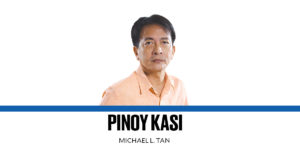Quarantine time need not be unproductive, especially if one is blessed with stable internet connection. By now, many people have gone beyond porn and Netflix to explore the explosion of online courses, webinars, and Zoom classes available for continuing education.
Harvard offers free courses, except an optional electronic certificate of completion that costs $50. You can study anything from conversational Swahili to Tibetan cuisine (substituting condensed milk for recipes that require fresh yak milk). Classic literature, or what universities call “Great Books,” is available in PDF or audio formats. You can learn Latin to be able to read the Vulgate, or Biblical Greek to read the New Testament in the original language.
Life is what we make it. Rather than be irritated by the President’s incoherent rambling, there are better ways to spend our time.
Life won’t return to “normal” for me after lockdown. I doubt if Ateneo will allow the 90-seater “magisterial” classes I have been handling for over a decade now. Neither will the Ayala Museum run my annual History Comes Alive lectures when it reopens next year after a delay in renovation. After two SRO crowds of over 600 people in my last lectures, I was declared a fire hazard, resulting in a 400-seat cap to the lectures and the requirement to point out emergency exits before I began. People have pointed out that I cannot lecture live all the time and have suggested Facebook streaming, which I rejected because some of my slides, pinched from the internet, might not be copyright-free. I allow all my lectures to be recorded for documentation only, but don’t allow these to be uploaded because a live lecture is not the same as an online one.
In a physical classroom, students have to endure the lecture till the bell rings. Nobody can leave unless they are threatened: externally by earthquake or fire, internally by a full bladder or an anxiety attack. However, you cannot sit through long periods of Zoom before minding distractions from the household setting, a cellphone, a pet, a cluttered background, or even a head of two-month overgrown hair. Instead of speaking for an hour straight, it makes sense to break up a lecture into four segments of 15 minutes each, the maximum length for Zoom attention span. In a live lecture, one can make mistakes or even do asides, but online one needs more preparation and practice with either a script or an outline. Then there is the need for tight post-production editing, so delivery flows with no hesitation or the “ahs” that fill dead air.
An opportunity to reach a wider audience, to teach beyond a physical classroom or lecture hall, is one of the welcome outcomes of the lockdown. And if it should be done at all, it should be done well. People who have watched me perform live know what it is like to use Keynote or PowerPoint well—less text, more pictures, tell a story. I don’t crowd slides with text in bad font and size. I never turn my back on the audience and read text off a slide to them like they are idiots. Many presenters forget that PowerPoint is a tool and not the presentation; the same goes for online learning. It’s not as simple as livestreaming from a classroom, because the medium affects the mode of delivery. If internet connection is bad, visuals or audio become choppy or delayed.
I have sampled enough webinars and FB Live to learn how not to do them. Minimum requirements are good audio, even flattering lighting, and a lot of practice. I have politely declined invitations to do FB Live lectures because if one has to do it at all in a new medium, it has to be done well. I am now experimenting with narration over my slides and saving these in mp4 for uploading. This way, one has clear images, legible text, and good audio to start.
I have never tired of Glenn Gould’s iconic recordings of J.S. Bach’s complete keyboard works. These come complete with Gould’s eccentric humming that critics wish were edited out, because they supposedly distract the listener from Gould’s execution of complicated fugues and counterpoint. But the humming provides the intimacy absent in most interpreters of Bach.
The new normal is an opportunity to teach differently to a bigger classroom, and I look forward to retiring from live lecturing to do recordings of my version of painless Philippine history.
Comments are welcome at aocampo@ateneo


